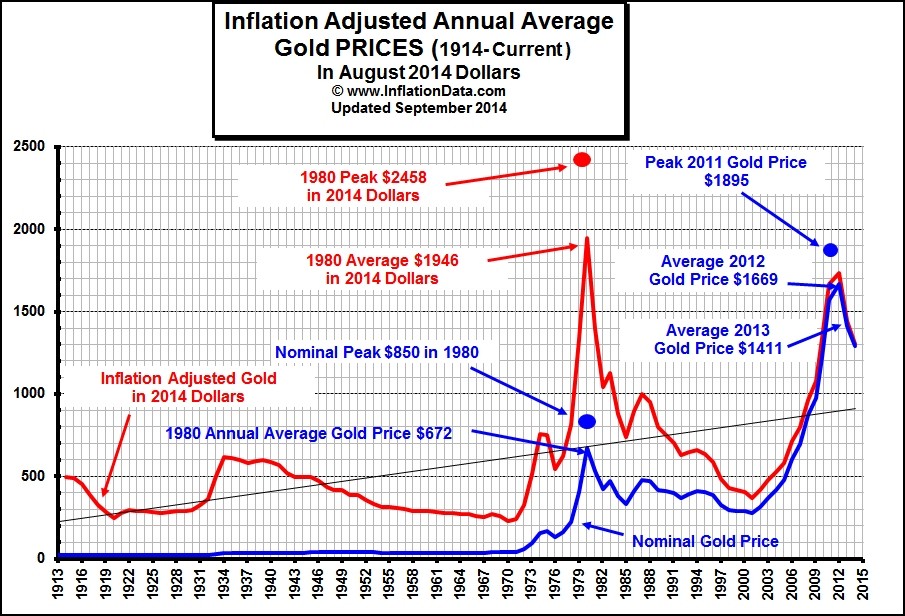Gold Not Much Of A Hedge For Anything Unless You re A Centurion
Post on: 18 Сентябрь, 2015 No Comment

Pretty to look at, but not much of an investment. (Photo credit: One Way Stock)
Gold has many uses, but as a hedge against inflation or a declining dollar, it’s a flop.
That’s the conclusion of an exhaustive article in the current issue of the Financial Analysts Journal, which examines six different explanations for why gold prices rise and fall. Authors Claude Erb and Campbell Harvey. a professor at Duke University ’s Fuqua School of Business. conclude that the assumptions of most investors — that gold rises during times of inflation, or serves as a hedge against a collapsing dollar — don’t measure up. The most likely explanation for why gold prices go up is because gold prices are going up.
Gold, like homes during the housing bubble, displays what economists call “positive price elasticity.” When the price is rising, investors are attracted to gold and buy more. Rising purchases by China and other emerging markets may have driven gold’s price up at the margin, but investors have piled on too. They’ve accumulated 1,000 metric tons of the barbarous relic in the vaults of the SPDR Gold Trust, more than China’s suspected gold inventory.
“The higher the past return of an asset, the higher the momentum investor’s demand for the asset,” the authors observe. What doesn’t drive gold’s cost, the authors conclude, are the things that many investors consider its most attractive attributes.
- Inflation hedge? Nope. A chart of gold prices versus year-to-year changes in inflation – one measure of unexpected inflation — shows a random cloud. Another chart showing the rolling 10-year return on gold versus Consumer Price Index also shows a random pattern. Trailing annual returns to gold investors ranged between almost negative 6% per year to nearly 20% between 1985 and 2012, while inflation rates showed a more narrow range of 2.3% to 7.3% a year. Conclusion: Investors can’t hedge against unexpected inflation by holding gold, since the returns from gold appear to have no clear relationship to inflation.
- Low interest rates? Nope. In theory, investors should shift from bonds to gold when real (after inflation) interest rates fall toward zero, since zero-yield gold becomes relatively more attractive because of its other supposed attributes (see above). And recent history supports the idea, with gold prices showing a -0.82 correlation with real yields since 1975 (meaning gold prices have tended to go up as real yields fall). But a longer-term study of U.K. returns has a correlation of -0.31, suggesting “real yields explained very little of the variation in the U.K. real price of gold.” A much better explanation is that gold prices go up because they’re going up. The so-called “time trend” correlation for the past 15 years is 0.87. That can’t continue forever, of course, and the recent correction might signal the beginning of a reversion back to the mean.
- Tail risk hedge? Nope. Even if buying gold doesn’t protect you against unexpected inflation, surely it should protect you against hyperinflation. But hyperinflation means one country’s currency depreciates rapidly, and gold is a global commodity. A prescient investor in Brazil who foresaw that country’s 250% annual inflation rate between 1980 and 2001 and bought gold at the beginning of that period would have seen his purchasing power decline by 70% as global gold prices fell. That’s better than the nearly 100% wipeout he would have endured in Brazilian bonds, but hardly an insurance policy.
- De facto world currency? If so, gold buys wildly different amounts of stuff at different times. Ray Dalio of Bridgewater Associates likes to discuss the “shadow gold price,” or the U.S. monetary base divided by the 8,300 tons of U.S. gold reserves. Depending on measure of money supply, gold should be worth $10,000 to $37,000 an ounce by that measure compared with its current price of around $1,290. But there is ample research showing little correlation between gold prices and money-supply growth rates. And the U.S. only owns 5% of global gold reserves, the authors point out, so why should one country’s monetary policies drive the worldwide price?
- Gold is under-owned. The authors like this explanation the best. The total gold supply is estimated at $9 trillion, or about 10% of the $90 trillion value of stocks and bonds traded worldwide. Investors own about $2 trillion of that. Given gold’s most attractive attribute, namely that it doesn’t correlate with paper investments, investors arguably should own more of it in their “market” portfolios. According to another theory, China should increase its gold stocks to protect against depreciation in its U.S. currency reserves. If China swapped its total foreign currency reserves for gold right now, it could buy about a third of the world’s above-ground supply. But remember, investor demand has positive elasticity with price. So as China tried to buy more gold, investors would demand more for it, and the price would skyrocket. Central banks also have agreed, under a set of inter-bank agreements, not to sell gold in quantities that will drive down the price. The combination of this cartel and China’s possible purchases at the margin, the authors say, could explain some of gold’s recent price rise.

Gold prices have fallen more than 30% from their peak in 2011, handing huge losses to investors like John Paulson and David Einhorn who saw gold as the perfect hedge against stimulus-driven inflation. And the authors say more losses may be in store.
Flash Player 9 or higher is required to view the chart
Click here to download Flash Player now
One way to evaluate the price of gold is to express it as a ratio of the nominal price to the level of the CPI. On that scale, gold traded at 3.36 times the CPI after futures trading was legalized again in 1975 in the U.S. It soared to nearly 9x the CPI in 1980, then plunged, hitting a low of 1.46 times in 2001. Since then it has skyrocketed again, to a current 7 times the CPI. The average over that period has been 3.2, meaning unless inflation heats up (and the caveats above prove false) gold’s price likely has a lot more reverting to do before it hits the mean.
Over the very long term, the authors note, gold does hold its value. The problem is, none of us will live that long. According to meticulous records kept by the Romans 2,000 years ago, a centurion under Emperor Augustus was paid about 38.6 ounces of gold per year. Converted into current U.S. dollars, that’s about 30% more than a modern-day captain in the U.S. Army.














